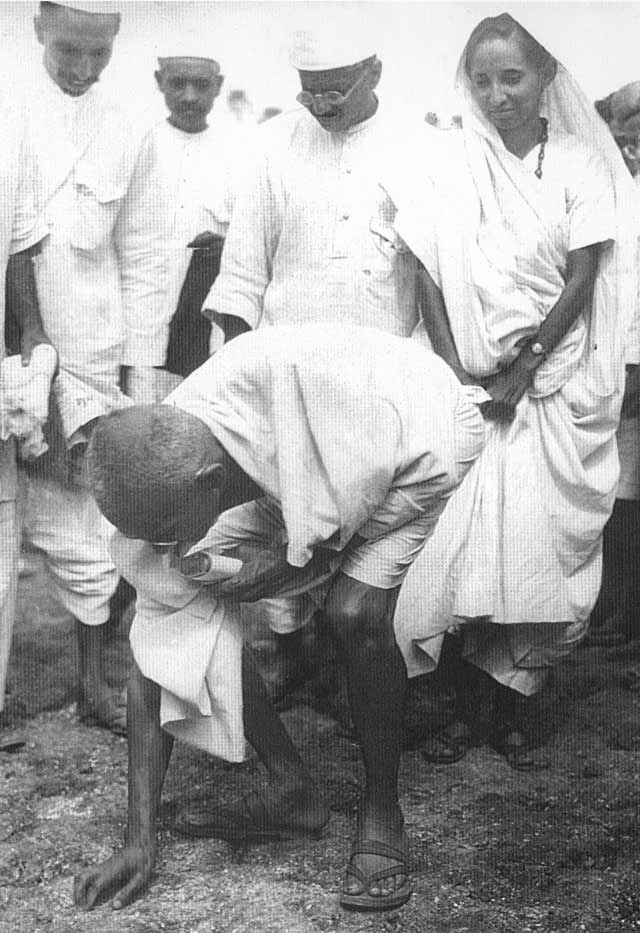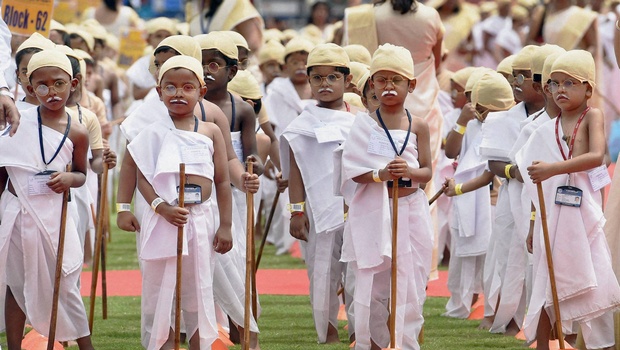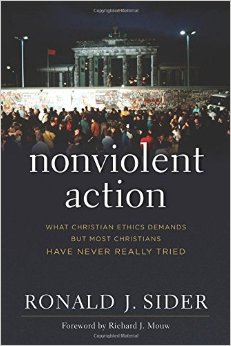by Fred J. Blum

Logo Shanti Sena World Peace Network; courtesy mettacenter.org
Editor’s Preface: The Peace Brigade was organized in 1981 by Narayan Desai and others in London, as an extension of the Shanti Sena, or nonviolent peace force, which Vinoba Bhave had founded in India in the 1950s. Bhave had, of course, taken his name and concept from Gandhi and more specifically from Gandhi’s Constructive Programme. This previously unpublished article makes clear that activists in the U.S. nonviolence and peace movements were already thinking of forming their own chapters as early as 1961, the date on the manuscript. The Brigade still continues in many countries under various names such as the World Peace Brigade, Peace Brigades International, Muslim Peacemaker Teams, etc.. The article is another in our series from the IISG archive in Amsterdam. For further information and references please consult the notes at the end of the article. JG
What is nonviolence? When I thought about how I wanted to start this discussion I felt a need to give some initial broad definition. The first that came to my mind was “to refuse to use violence and to substitute for it other means.” As soon as I had written it down, I felt that the term “to use violence” was very limiting, and expressed a mode of thinking so prevalent today that none of us could easily escape from it, namely a thinking in instrumental terms: of using techniques, of making “things” an instrument for our purpose, for controlling our environment, etc.
Read the rest of this article »
by William J. Jackson

Gandhi gathers salt and breaks law; courtesy Wikipedia.com
Why Symbolism of Salt to Understand a Trouble Dissolver?
Alchemy is a kind of learning, a repository of old wisdom. It includes observations about elements, experiments with materials and aspects of the universe, as well as studies about processes and psyches. The imagination of curious souls and observers of life, active over the centuries, has experimented and found meanings in chemical and psychic interactions and transformations.
Despite modern science’s new technologies and ways of learning about the universe at various levels—micro, macro, meso—there are still valuable lessons to be learned from the ideas gathered under the term “alchemy” over the centuries. Shakespeare and other great poets are still interesting 500 years later—his grasp of human nature, his use of metaphorical language, and his observations on experience are still valuable, and this is true also for the metaphors found in alchemy.
James Hillman’s Alchemical Psychology is a brilliant contribution to understanding the richness of alchemy. In this book he garners and examines some valuable insights from the explorations of alchemy, and relates them to the processes of the human psyche. Many of the ideas in this paper are derived from Hillman’s inspiring work. I quote some points directly, others I paraphrase and elaborate on, extending them with my own examples and explicating and exploring their implications. Relating these ideas to Gandhi’s work is my idea, not Hillman’s. (1)
Read the rest of this article »
by Geoffrey Ostergaard

Logo Sri Lanka sarvodaya; courtesy lightmillennium.org
In March 1974, following a student demonstration in Patna against the Bihar Government and Assembly that resulted in widespread arson and looting and several deaths, Jayaprakash Narayan (JP) the leader of the Socialist Party and former Gandhi supporter, accepted an invitation from the student leaders to give guidance and direction to their movement. As he was to declare in a speech to these students, ‘After 27 years of freedom, people of this country are wracked by hunger, rising prices, corruption… oppressed by every kind of injustice… it is a Total Revolution and we want nothing less!’
His immediate purpose was to ensure that the developing agitation would be peaceful and nonviolent but, in accepting the invitation, he set in motion a train of events which included not merely splitting the Sarvodaya movement of which he was the most prominent leader after Vinoba Bhave but also, and more importantly, polarising all the major political parties and forces in India. Fifteen months later, this polarisation led to a head-on confrontation between the Opposition parties and the Central Congress Government (supported by the Communist Party of India), the outcome of which was the declaration of a state of emergency on 26th June 1975.
Read the rest of this article »
by Beverly Woodward
Editor’s Preface: This previously unpublished 1972 essay by Beverly Woodward is the latest in our series of discoveries from research that we are conducting in the IISG, Amsterdam. Please see the notes at the end for further details, references, acknowledgments, biographical information, and a link to the pdf file of the original. JG
The existing state of international disorder is often referred to as a state of global anarchy. The time honored human remedy for such a state of affairs is the establishment of the rule of law. Thus the remedy for the existing situation is often held to be the creation of more and better international law along with the creation of the institutions customarily associated with the presence of law, i.e., institutions for making, interpreting, and enforcing law. But there are many who are not enthused by the proposal. They include those national elites who speak piously of “law and order” at home, but are definitely less reverent when it becomes a question of forms of law that might be less supportive of their (self-defined) “interests” than the legal structures that they are so anxious to see upheld. They include the anarchists who insist that the current perversions in human behavior are not due to too little law, but to too much law, pointing out, for example, that it is governments that have authorized the great majority of the more brutal and massively destructive acts witnessed in this century. And they include many “ordinary people” who are neither opposed to law in general nor especially privileged by the given arrangements, but who are apprehensive of law formulated at such a great distance from its potential points of application. Even to those not inclined to rail against government wherever it occurs, “world government” or anything similar may seem a rather frightening remedy for what ails us.
Read the rest of this article »
by Devi Prasad

Schoolchildren dressing as Gandhi to commemorate his 146th birthday; courtesy newindianexpress.com
Editor’s Preface: This previously unpublished essay by Devi Prasad is another in our series from the IISG archive, Amsterdam. It is well to bear in mind that Prasad lived as a child at Tagore’s school, discussed in the article, and that he was later asked by Gandhi to teach in one of his ashrams. His knowledge of Gandhi’s education system, therefore, was uniquely first-hand. Please consult the notes at the end for archival reference, acknowledgments, and biographical information. JG
At the centre of Gandhi’s many concerns about social and political issues, there are two things that remained consistently predominant throughout his life. Firstly, a revolt against the education system that was given to, nay, imposed upon India by the colonial rule; and secondly, a powerful urge to find an appropriate approach and method of imparting education to all the children and adults of the country.
Read the rest of this article »
by Tristan K. Husby

Dustwrapper art courtesy Brazos Press; bakerpublishinggroup.com
A friend of mine who is an organizer and nonviolence trainer has a favorite exercise called “10-10,” which she uses when introducing nonviolence to new activists. She divides the students into groups and tells them to write down, as quickly as possible, 10 wars. Afterwards, they review all of the different wars that people have recalled. While there are a number of wars that are repeated, often each group has come up with some war that other groups have not thought of at all. When I first participated in this exercise, I was excited to contribute the rather obscure Corinthian War. Then she asks the groups to write down 10 nonviolent struggles. This task always takes longer and some groups run out of time before they can complete the task.
The point of the “10-10” exercise is to drive home how our society pays close attention to wars and violent conflicts: We devote countless news articles, books and classes to retelling the history of these violent events. It is not surprising then that for the past 40 years much of the literature on nonviolence has been historical. Scholars and writers have uncovered, recorded and preserved examples of nonviolent struggles from across the world and from many different time periods so that activists can know for themselves and convince others of the efficacy of people power. Other writers, such as the philosopher Todd May and the theologian Ronald Sider, have adopted this idea of historical research being necessary to argue about and promote nonviolence in new books that they have each published.
Read the rest of this article »









